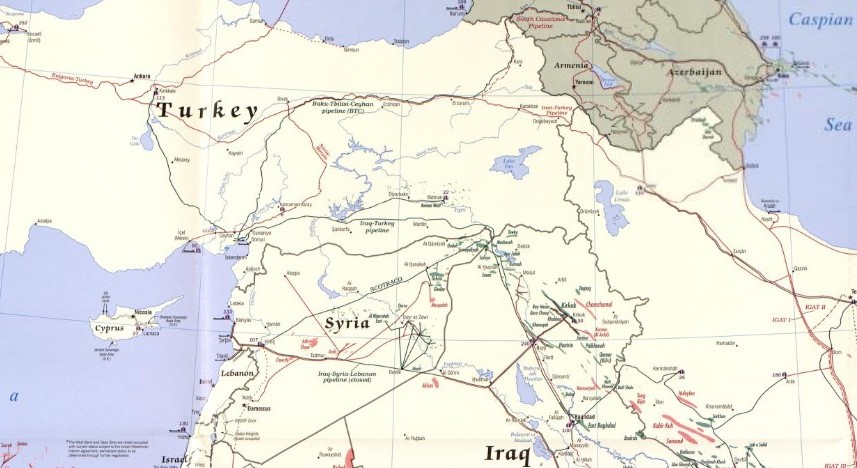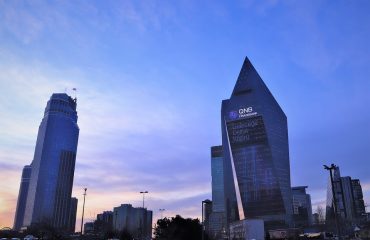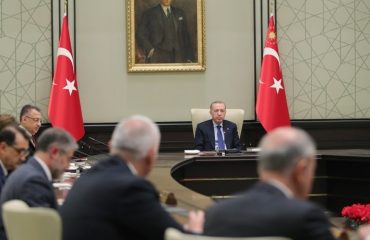

Iraq wants to diversify its export routes and reopen the Kirkuk-Baniyas oil pipeline, which could redraw the energy map of the Middle East and sideline Turkish interests. (Map: US Library of Congress)
The energy map of the Middle East may be redrawn with the revival of the Kirkuk–Baniyas oil pipeline—a move that could sideline Türkiye. Iraq’s decision to bring back to life the pipeline connecting Kirkuk with Syria’s Mediterranean port city of Baniyas is not merely an infrastructure investment; it’s a strategic maneuver capable of shifting the region’s balance of power. Should this corridor become operational, Türkiye risks losing vital transit revenues and its claim to be the regional “energy hub.” Ankara can no longer afford to sleep through this.
Iraq’s quest for export diversification
As the second-largest oil producer in OPEC after Saudi Arabia, Iraq plays a critical role in global energy markets, pumping over 3.5 million barrels of oil per day. However, 85% of this output depends on the Persian Gulf. Any escalation in the Strait of Hormuz—be it sanctions, maritime insecurity, or geopolitical tensions—could abruptly disrupt billions of dollars in revenue for Baghdad.
While the Kirkuk–Ceyhan pipeline once carried 400,000–500,000 barrels per day, legal disputes and persistent security challenges have left it nearly dormant in recent years. Ankara has leveraged this reality in negotiations. For Iraq, however, the top priority is diversifying export routes—and this is precisely where the Kirkuk–Baniyas corridor steps in.
Baniyas as a Ceyhan alternative?
Despite the severe damage inflicted on Syria’s economic infrastructure during the civil war, the Baniyas Port on the Mediterranean remains operational. A revived pipeline from Kirkuk to Baniyas would provide Iraq with a direct outlet to the Mediterranean and a shorter route to European markets.
True, the Ceyhan/Yumurtalık terminal currently handles not only oil from Kirkuk and Mosul but also Azerbaijani crude. Still, a functioning Kirkuk–Baniyas line could turn Syria into an increasingly relevant energy hub during its post-war reconstruction, generating vital revenue for the Assad regime and restoring some of its lost geopolitical clout.
Implications for Kurdish-controlled regions
For years, oil fields controlled by the Kurdistan Regional Government (KRG) in northern Iraq provided a de facto independent income via exports through Ceyhan. However, a 2023 ruling by the International Arbitration Court has largely disrupted this flow, triggering a financial crisis for the KRG.
If the Kirkuk–Baniyas pipeline becomes operational, Baghdad could regain full control over oil revenues from the north, undermining one of the key economic pillars of Kurdish autonomy and pulling the region back under central authority.
On the Syrian side, while eastern oil fields in Deir ez-Zor and Hasakah remain under U.S.-backed SDF/YPG control, Damascus hopes that reviving the Baniyas corridor will allow it to gradually reassert control over these energy-rich zones. This will likely test the SDF’s political and economic autonomy aspirations once more.
If activated, the Kirkuk–Baniyas corridor could tarnish Türkiye’s image as the region’s fastest and most reliable energy transit route, reducing its energy revenues, bargaining power, and strategic influence.
Four critical action points for Türkiye
The “sleeping beauty” is stirring—and Türkiye must not be caught napping. Before this corridor redraws the energy map, Ankara must immediately implement the following:
- Modernize the Kirkuk–Ceyhan pipeline: Accelerate upgrades in maintenance, security, and digital monitoring to demonstrate that Türkiye remains the most viable export gateway for Iraqi oil.
- Develop new trade and investment models: Make the Kirkuk–Ceyhan route economically attractive through joint refinery ventures, free energy zones, investment incentives, and guaranteed purchase agreements.
- Mediate between KRG and Baghdad: Rebuild trust in the Ceyhan route by crafting a fair revenue-sharing mechanism that also addresses the economic concerns of the Kurdish region.
- Initiate energy diplomacy with Syria: Offer technical support for rehabilitation of energy infrastructure in SDF-controlled fields and position the Baniyas route as a complementary, not rival option.
Time is of the essence
The Kirkuk–Baniyas corridor is no longer a dormant project behind closed doors. If it becomes operational, it could redefine the region’s energy dynamics in ways detrimental to Türkiye’s strategic interests. Energy flows will always find a way—Türkiye must act before it loses the initiative.
If Ankara fails to launch a comprehensive, long-term strategic response—beyond temporary fixes—it risks watching its dream of becoming an “energy hub” evaporate. The price: lost revenues, diminished regional influence, and weakened geopolitical leverage.
The “sleeping beauty” is awakening—and unless Türkiye rewrites the playbook, it may soon find itself written out of the script.


